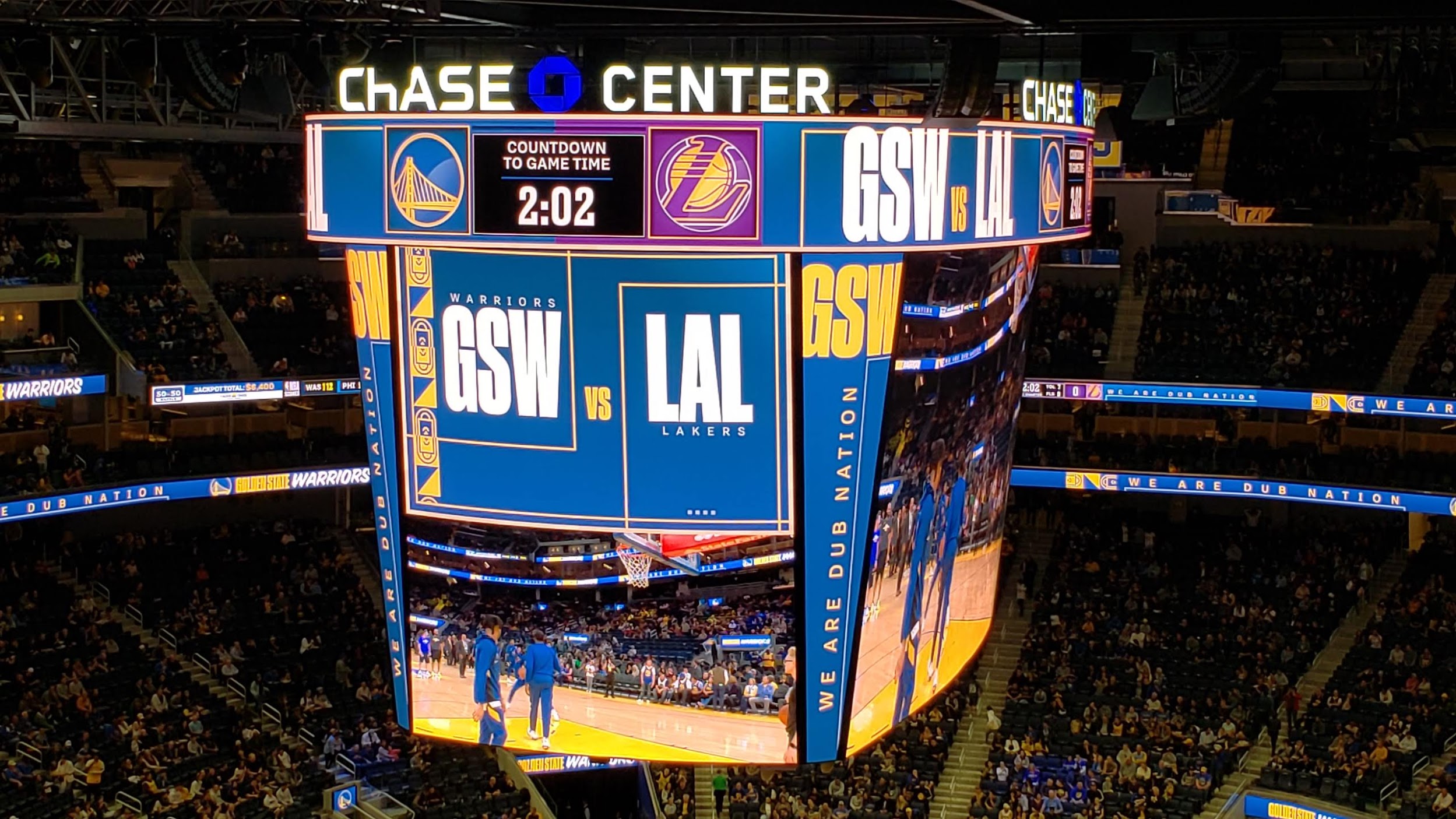
NBA’s Warriors Light Up LED-laden New Home Court Building In San Francisco
October 21, 2019 by Dave Haynes
Sports and entertainment venues have long been an opportune market for digital signage vendors because of the need for owner/operators to both communicate a lot of changing information, and drive the visual excitement of the event experience.
They’re also opportune because venue operators are pretty steadily looking to up their technology game, particularly with newly built facilities. That tends to equate to more and more screens.
That story is particularly true with Chase Center, the newly opened home of the NBA’s Golden State Warriors. The new arena is in a brownfields section of San Francisco, on the waterfront south of the central business district, and just a bit further south from where the Major League Baseball team plays.
The team had, for 40 years, been playing across the bay in Oakland, and the new facility that opened this fall was the end-result of some seven years of planning, zoning applications, legal fights and then construction.
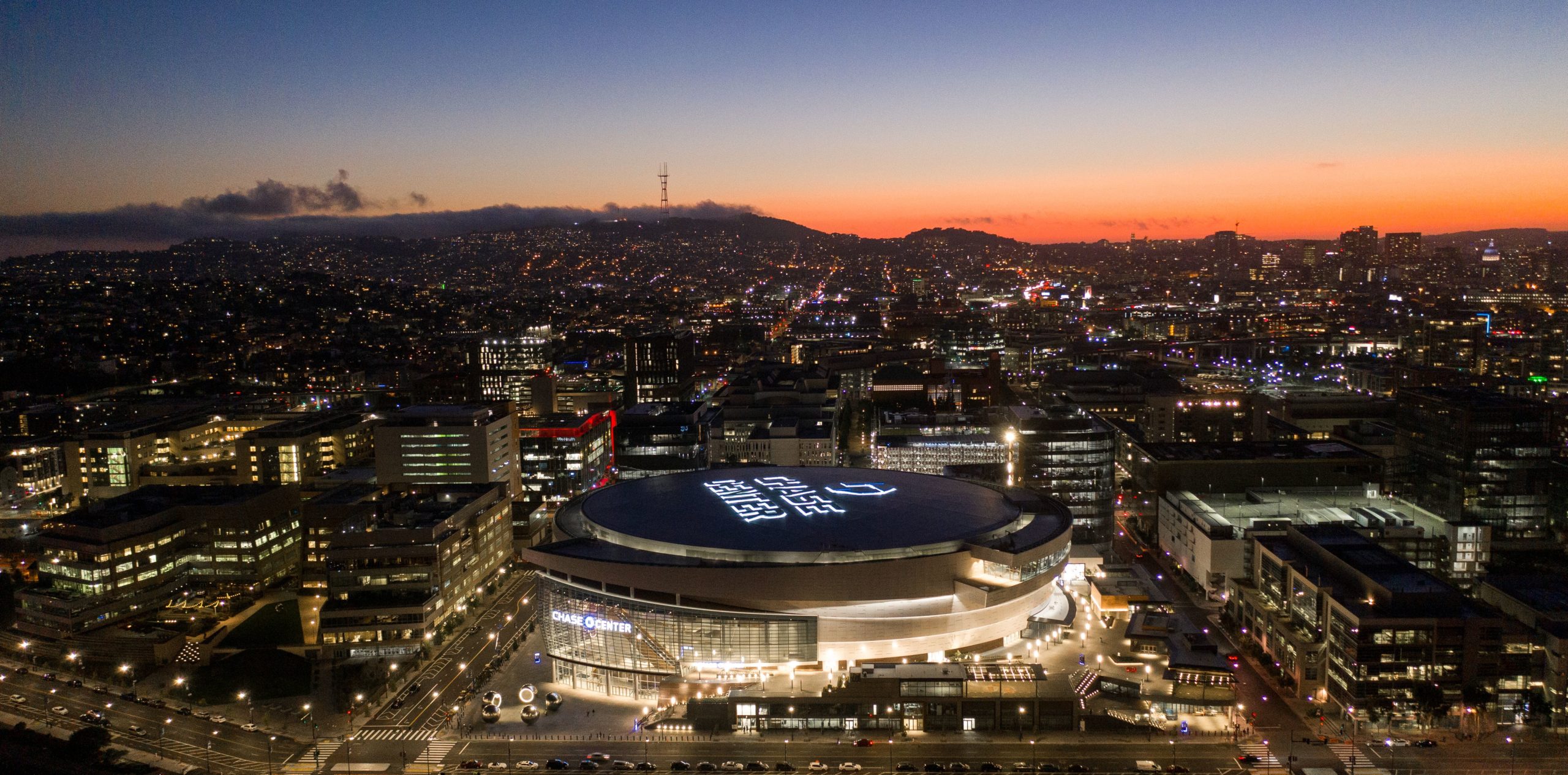
Somewhat uniquely for these days, the building went up all with private dollars – something much more possible in a region with no end of Silicon Valley billionaires. Normally these days, new arenas and stadiums are private-public “partnerships” that see government funds and/or tax concessions put in, with the hope/expectation that there will be spin-off economic benefits for the city.
Samsung and its PRISMVIEW LED display subsidiary are the display technology partners on the new building, and they invited a bunch of journalists who cover signage and sports technology to fly in, stay and see the new digs at the end of last week. I went along (for transparency, they paid my way), and got a facility tour on Friday through the day, and a look at all the screens in use at an exhibition game that night.
It’s impressive, inside and out.
The arena has the largest center-hung scoreboard in the NBA – which can disappear into the rafters when concerts are on – and a huge 10mm LED screen on the outside of the building, facing a public plaza. That screen will be used on game days for fans who want to be part of the game day experience, but don’t have tickets. The Toronto Raptors, who, ummm, beat the Warriors in the NBA finals, have a huge outdoor LED on a plaza outside of its arena (and it was recently upgraded).
In all, there are more than 64 LED screens around the new arena. Most of it is PRISMVIEW, the outdoor and scoreboard specialist that Samsung owns and very recently rolled formally under its sales umbrella. There are also fine pitch LED displays in public areas inside, as well as in the post-game media center, where it is used as a logo’d backdrop for interviews with players and coaches.
“A project of this size and scope doesn’t happen overnight. It took years of planning and working side-by-side with the Warriors organization to ensure that the center-hung structure and LED video displays met all of the weight and engineering requirements to deliver an amazing experience,” says Don Szczepaniak, the CEO of PRISMVIEW.
That center scoreboard is quite something, with 9,699 square feet of active video display, spanned across 15 different displays that make up the overall unit. The main screens fans see are 6.7mm pixel pitch, but there are 4mm screens kind of inside and below the jumbo unit that are angled at and intended for the high-dollar fans sitting at floor level. In most arenas, fans in the most expensive seats have to look waaaaay up to see the scoreboard for replays and stats.
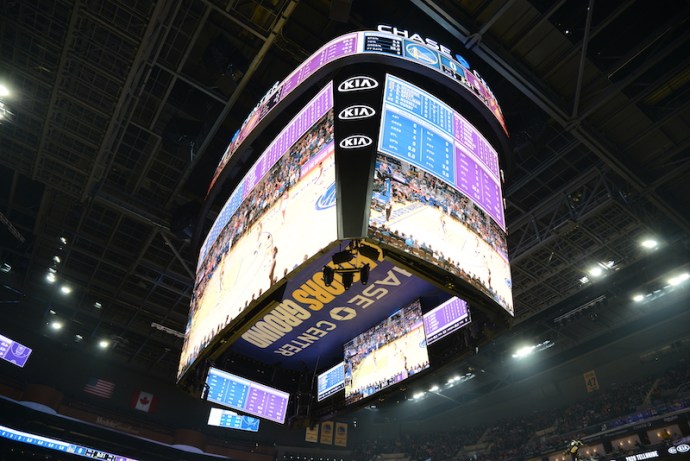
The next biggest LED scoreboard is up the road in Sacramento, and is about a third smaller, at 6,100 square feet.
“Our fans are some of the most knowledgeable fans in sports and as we had the opportunity to build a new arena we knew our scoreboard would be key in the overall fan experience at Chase Center,” says Warriors President and COO Rick Welts, who walked the media around the facility. “In addition to having the most square footage of surface LED space in the NBA, the capabilities are endless – providing fans everything they need to follow the game including rich content, expanded stat categories, the ability to show stats for every player on the team at the same time, a real-time shot chart and much more.”
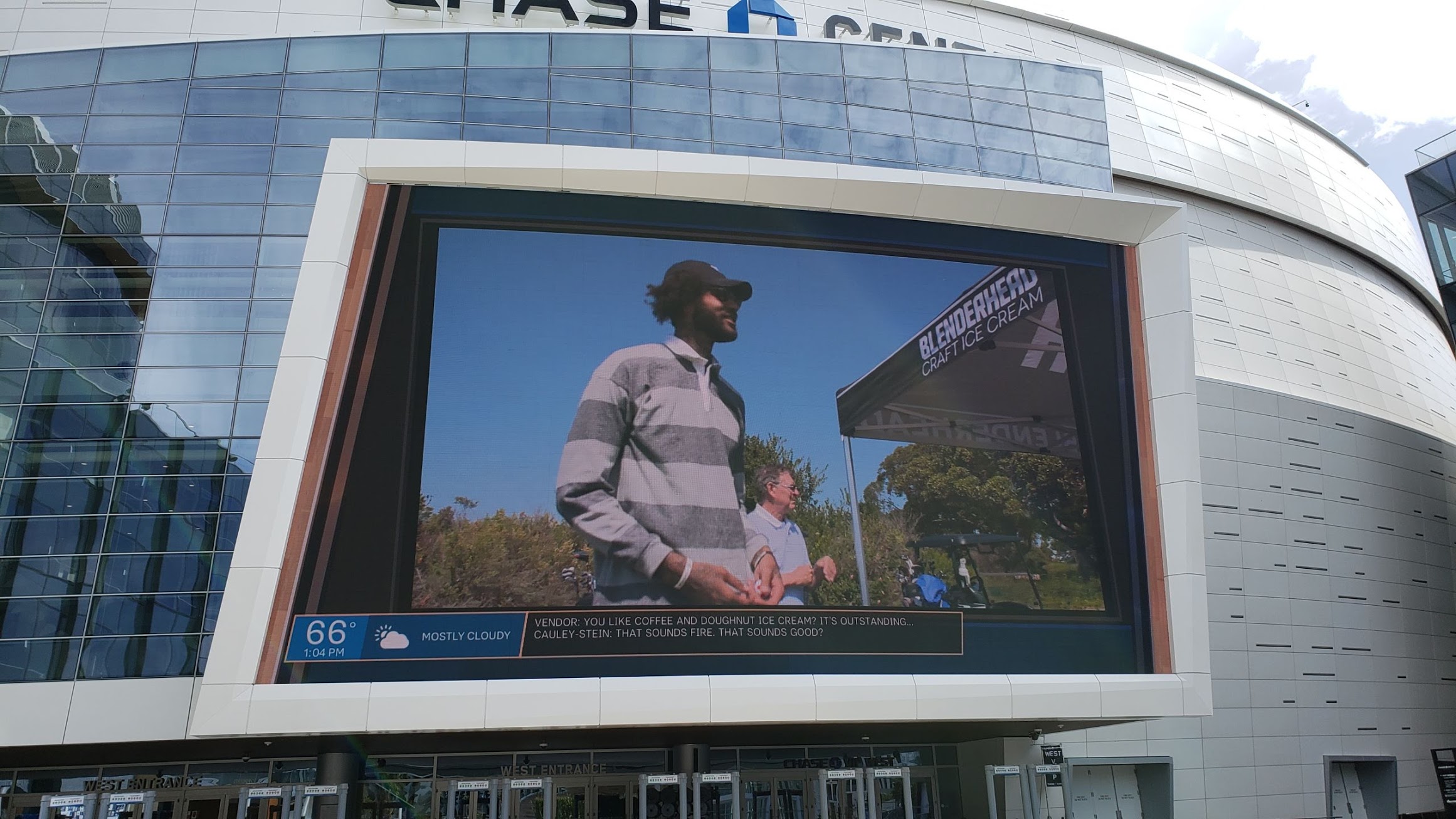
The outside screen is 10 mm, facing west and running things like broadcast feeds of the game, as well as promotions. It is across a plaza from where a new LRT line drops off fans, and is also in view of a glassed-in broadcast studio used by sports networks.
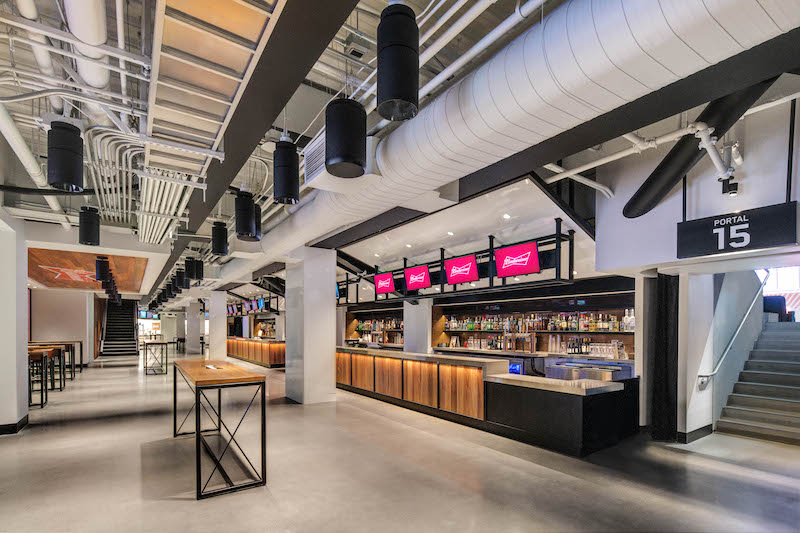
There are also some 1,100 Samsung LCD flat panels used around the building for concessions – most of the food operators have digital menu displays – and in the corporate suites for IPTV and messaging.
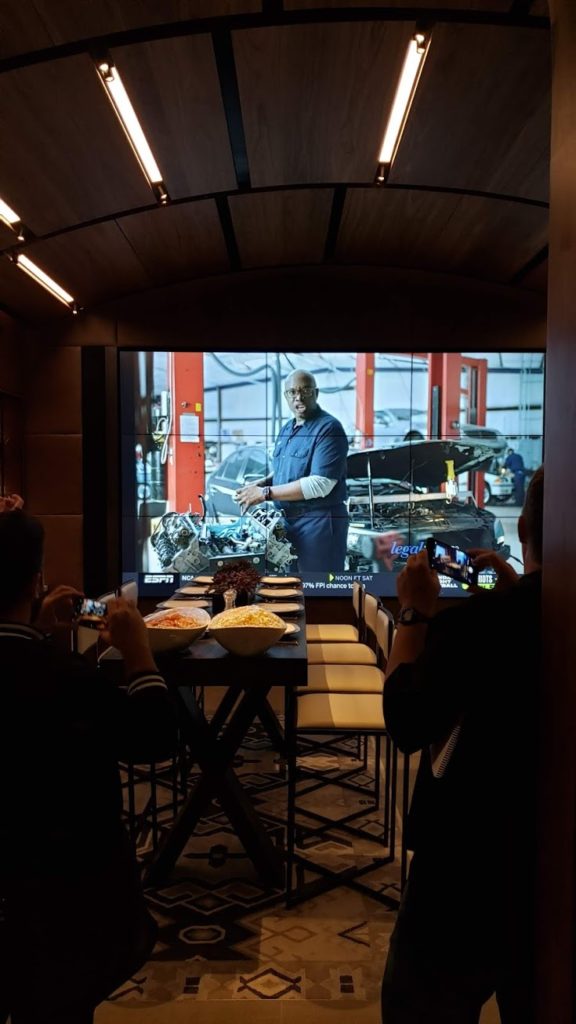
We had a peek in one of the primo suites that people sitting at or near courtside use before and during games. They had tiled LCD video walls in each, and looked like cushy wine cellars. I asked Welts how much, and he said $2 million a year, with a long-term commitment. I said I’d need to think on that and get back to him.
One of the really interesting things about this was hearing of the commitment to getting the content right, and treading the line between marketing demands and fan experience. The arena, we were told, has about 40 per cent more LED screens than other arenas in the league, so it could easily start to feel like Times Square. The team deals with that by having a large, dedicated creative team in-house that develops material tuned to the format and done, where possible, in ways that fit the moods and moments, as opposed to BUY THIS NOW! stuff.
I think the folks said they had 38 people on the overall game day/event day visuals team, including operators of some very sophisticated show control systems. There are 10 creatives working on the graphics and video.
That’s not typical, I was told, with other arenas/teams having much smaller staffs and, in some cases, creative that’s outsourced or done by agencies based on provided specs.
The audio in the building is also phenomenal, as you might expect.
These are the specs I was provided, including for the very weirdly named “vomitorium” entrance headers. Most of the tech was PRISMVIEW, but the fine pitch LEDs were Samsung’s, as were any LCD tech:
- Seating Bowl, West Vomitorium, Club Displays (5) – 10mm – 4ft-3in wide x 2ft-2in high
- Lower Bowl, East and West Vomitorium, Courtside Lounge Bulkhead Displays (4) – 10mm – 3ft-11in wide x 2ft-3in high
- Lower Bowl, West Vomitorium, Courtside Club Displays (4) – 10mm – 9ft-9-3in wide x 2ft-3in high
- Floor Vomitorium, Corner Tunnel Displays (1) – 10mm – 5ft-6in wide x 2ft-2ft high
- Floor Vomitorium, Corner Tunnel Displays (1) – 10mm – 16ft-4in wide x 2ft-2ft high
- Floor Vomitorium, Corner Tunnel Displays (1) – 10mm – 16ft-4in wide x 2ft-2in high
- Floor Vomitorium, Corner Tunnel Displays (1) – 10mm – 5ft-5in wide x 2ft-2in high
- Main Concourse, North Vomitorium, Lower Extension Bulkhead Center Display (1) – 10mm – 15ft-2in wide x 2ft-2in high
- Main Concourse, North Vomitorium, Lower Extension Bulkhead Side Displays (2) – 10mm – 15ft-2in wide x 2ft-2in high
- Seating Bowl, End Bowl Sponsor Displays (2) – 10mm – 31ft-5in wide x 2ft-2in high
- Seating Bowl, Upper Wall Corner Displays (4) – 10mm – 10ft-10in wide x 2ft-2in high
- Suite Level, Fascia Display (1) – 10mm – 711ft wide x 2ft-6in high
- Upper Suite – 400 Level, Fascia Display (1) – 10mm – 631ft-11in wide x 2ft-6in high
- Upper Concourse, Bridge Display (1) – 10mm – 128ft-11in wide x 4ft in high
- Scorer’s Table Displays (4) – 24ft wide x 4ft high
- Basketball Goal, Stanchion Displays (4) – 46in wide x 12in high
- Theatre, North Facing Displays (2) – 10mm – 30ft wide x 7ft-10in high
- Theatre, South Facing Displays (2) – 10mm – 30ft wide x 7ft-10in high
- Theatre, Halo East Facing Display (1) – 10mm – 80ft wide x 7ft-10in high
- Theatre, Halo East Facing Display (1) – 10mm – 80ft wide x 7ft-10in high
- Post-Game Interview Room Display (1) – 22ft wide x 8ft-10in high
- Main Concourse, Lobby Display (1) – 33ft wide x 7ft-1in high
- Plaza Entrance Display (1) – 10mm – 74ft wide x 42ft high
- Theatre Entrance Display (1) – 10mm – 141ft wide x 2.7ft high
- Gatehouse, Ribbon Display (1) – 10mm – 100ft wide x 3ft high
- Ticket Window Displays (1) – 5mm – 20in wide x 5in high
- Locker Room Game Clocks (38) – 20in wide x 8in high
- Fixed Digit Scoreboards (4) – 6ft wide x 3ft-6in high
- Samsung SMART Signage Professional Displays (1,100)
Chase Center Centerhung:
- Centerhung Outside, Side Displays (2) – 6.7mm – 57ft-4.5in wide x 34ft-9in high
- Centerhung Outside, End Displays (2) – 6.7mm – 27ft-4.5in wide x 34ft-9in high
- Centerhung Outside, Corner Displays (4) – 6.7mm – 9ft-3in to 3ft-8in wide x 34ft-7.5in high
- Centerhung Inside, Side Displays (2) – 4mm – 24ft-6in wide x 13ft-10.75in high
- Centerhung Inside, Wing Displays (2) – 4mm – 10-7.75in wide x 6ft-1.25in high
- Centerhung Inside, End Displays (2) – 4mm – 20ft-2.125in wide x 7ft high
- Centerhung Outside, Upper Ring Halo Display (1) – 6.7mm – 236ft-8in wide x 8ft-6.25in high
- Centerhung Outside, Chase Center Channel Letter Signage
The presence of 1.5mm pitch LED walls on the main concourse made me a little jumpy, as these things are fragile and just brushing a hand along a typical module can cause damage. But the one I saw had an airport line barrier belt thingie (no idea what those are really called) in front of it.
A 1.5mm looks great and, as you can see, is crisp enough to properly replicate the fonts of sponsors (see right side).
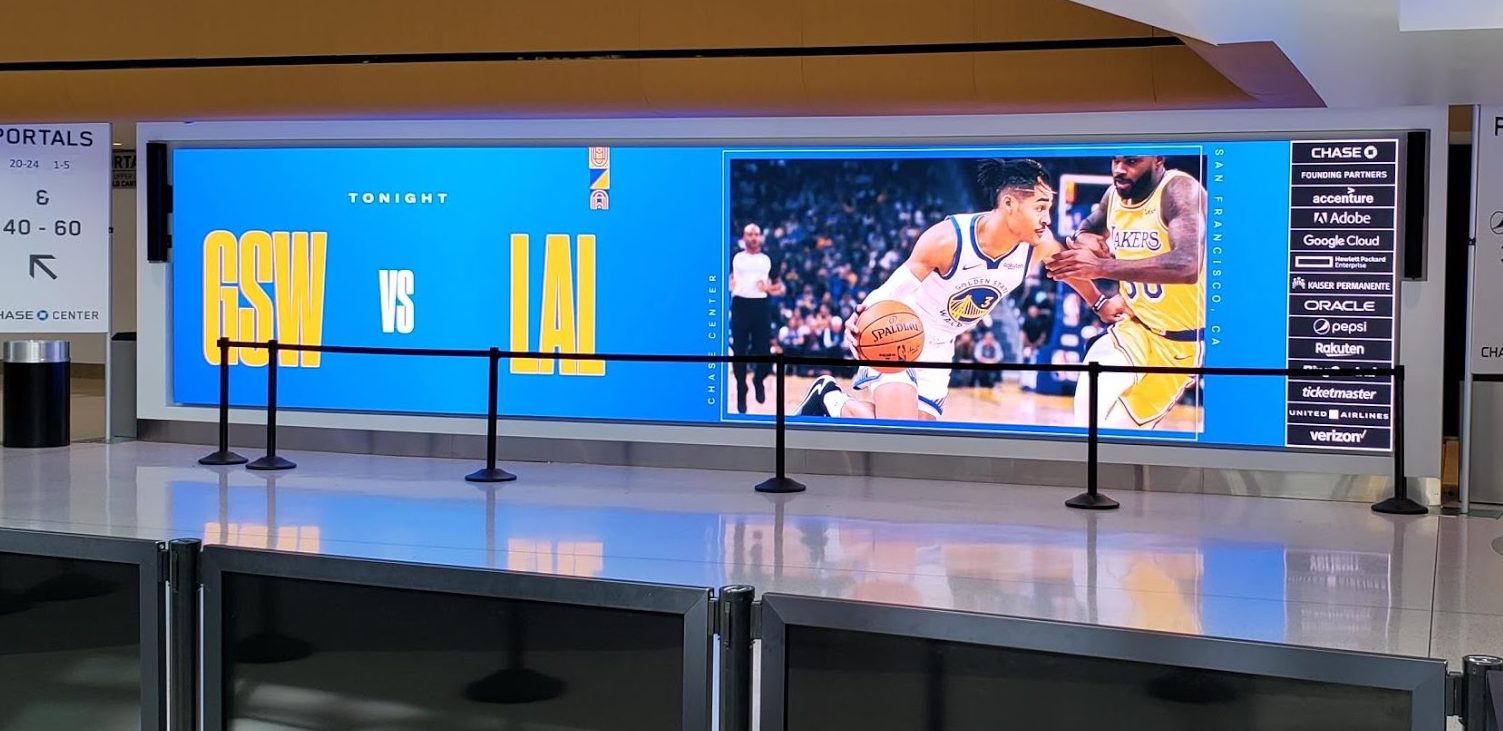
Overall, it’s a really impressive build-out and Lord knows what all that AV cost. I asked, and as expected, didn’t get a number. Lots and lots, I’d assume. But then the building cost around $1.4 billion, so the LED was, in relative terms, a rounding error.
Between naming rights, corporate box commitments and revenue from retail and office space on the complex, that $1.4B is already covered. Silicon Valley is pretty unique, as mentioned, but it would be great to see this as the model for new sports buildings, instead of teams blackmailing cities and counties, looking for construction dollars or other concessions.
If you are lucky enough to catch a game there, your eyes will pop.



Leave a comment